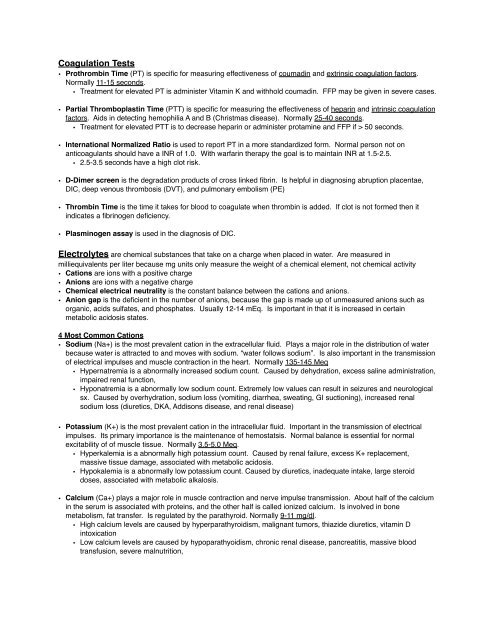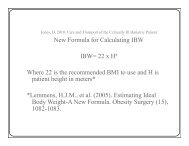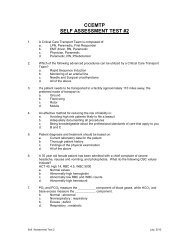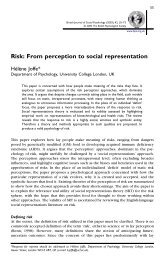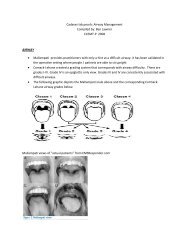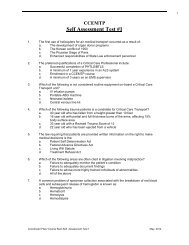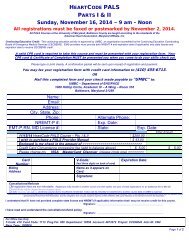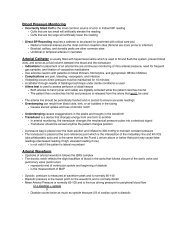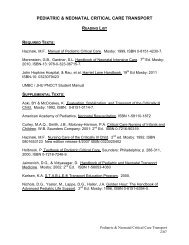Complete Blood Count (CBC)
Complete Blood Count (CBC)
Complete Blood Count (CBC)
- No tags were found...
Create successful ePaper yourself
Turn your PDF publications into a flip-book with our unique Google optimized e-Paper software.
Coagulation Tests• Prothrombin Time (PT) is specific for measuring effectiveness of coumadin and extrinsic coagulation factors.Normally 11-15 seconds.• Treatment for elevated PT is administer Vitamin K and withhold coumadin. FFP may be given in severe cases.• Partial Thromboplastin Time (PTT) is specific for measuring the effectiveness of heparin and intrinsic coagulationfactors. Aids in detecting hemophilia A and B (Christmas disease). Normally 25-40 seconds.• Treatment for elevated PTT is to decrease heparin or administer protamine and FFP if > 50 seconds.• International Normalized Ratio is used to report PT in a more standardized form. Normal person not onanticoagulants should have a INR of 1.0. With warfarin therapy the goal is to maintain INR at 1.5-2.5.• 2.5-3.5 seconds have a high clot risk.• D-Dimer screen is the degradation products of cross linked fibrin. Is helpful in diagnosing abruption placentae,DIC, deep venous thrombosis (DVT), and pulmonary embolism (PE)• Thrombin Time is the time it takes for blood to coagulate when thrombin is added. If clot is not formed then itindicates a fibrinogen deficiency.• Plasminogen assay is used in the diagnosis of DIC.Electrolytes are chemical substances that take on a charge when placed in water. Are measured inmilliequivalents per liter because mg units only measure the weight of a chemical element, not chemical activity• Cations are ions with a positive charge• Anions are ions with a negative charge• Chemical electrical neutrality is the constant balance between the cations and anions.• Anion gap is the deficient in the number of anions, because the gap is made up of unmeasured anions such asorganic, acids sulfates, and phosphates. Usually 12-14 mEq. Is important in that it is increased in certainmetabolic acidosis states.4 Most Common Cations• Sodium (Na+) is the most prevalent cation in the extracellular fluid. Plays a major role in the distribution of waterbecause water is attracted to and moves with sodium. “water follows sodium”. Is also important in the transmissionof electrical impulses and muscle contraction in the heart. Normally 135-145 Meq• Hypernatremia is a abnormally increased sodium count. Caused by dehydration, excess saline administration,impaired renal function,• Hyponatremia is a abnormally low sodium count. Extremely low values can result in seizures and neurologicalsx. Caused by overhydration, sodium loss (vomiting, diarrhea, sweating, GI suctioning), increased renalsodium loss (diuretics, DKA, Addisons disease, and renal disease)• Potassium (K+) is the most prevalent cation in the intracellular fluid. Important in the transmission of electricalimpulses. Its primary importance is the maintenance of hemostatsis. Normal balance is essential for normalexcitability of of muscle tissue. Normally 3.5-5.0 Meq.• Hyperkalemia is a abnormally high potassium count. Caused by renal failure, excess K+ replacement,massive tissue damage, associated with metabolic acidosis.• Hypokalemia is a abnormally low potassium count. Caused by diuretics, inadequate intake, large steroiddoses, associated with metabolic alkalosis.• Calcium (Ca+) plays a major role in muscle contraction and nerve impulse transmission. About half of the calciumin the serum is associated with proteins, and the other half is called ionized calcium. Is involved in bonemetabolism, fat transfer. Is regulated by the parathyroid. Normally 9-11 mg/dl.• High calcium levels are caused by hyperparathyroidism, malignant tumors, thiazide diuretics, vitamin Dintoxication• Low calcium levels are caused by hypoparathyoidism, chronic renal disease, pancreatitis, massive bloodtransfusion, severe malnutrition,


